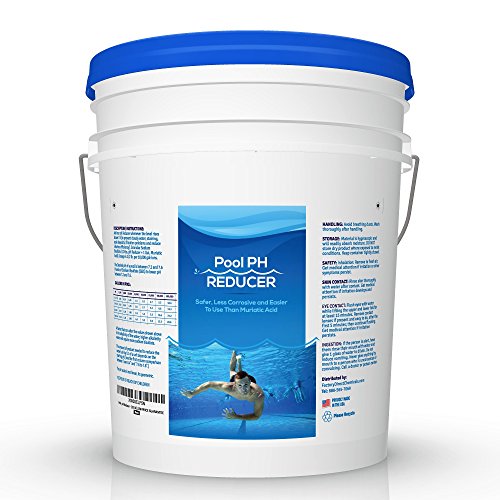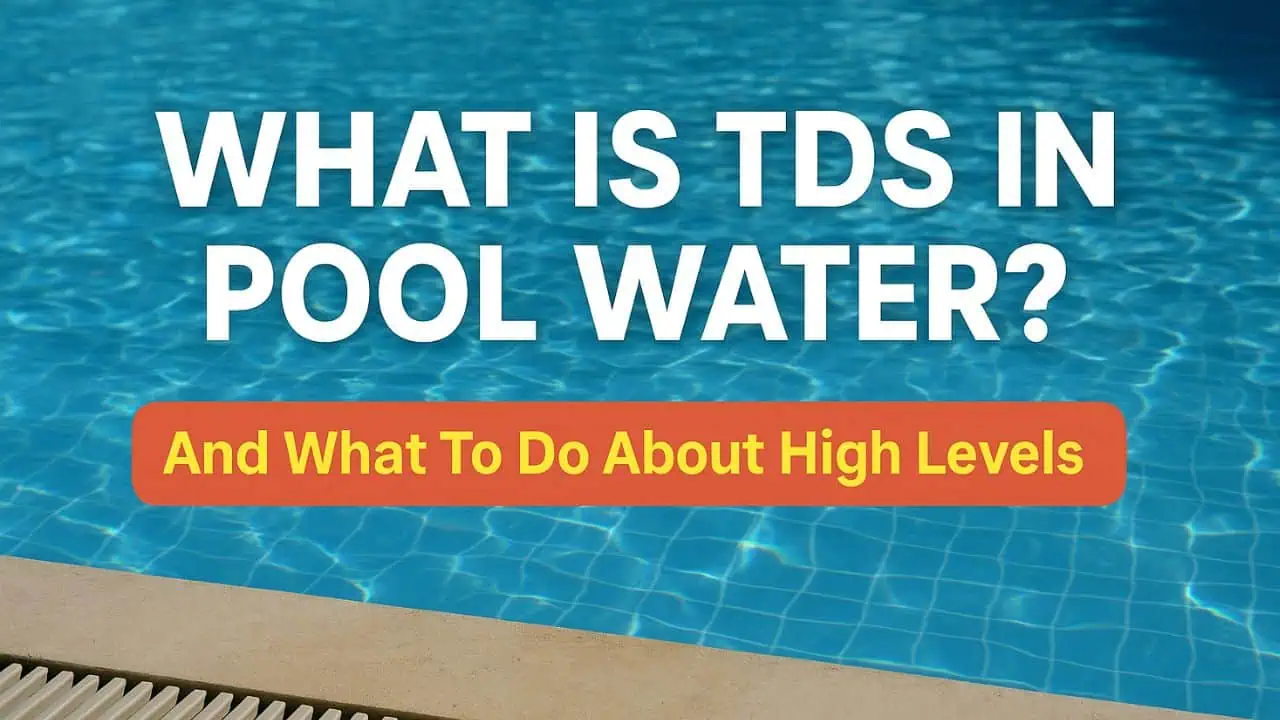Maintaining the appropriate pH level in a swimming pool ensures swimmers’ health and safety and prevents damage to pool equipment and structure.
When the pH level in a pool becomes too high, it can lead to problems such as skin irritation, cloudy pool water, and decreased effectiveness of sanitizing chemicals.
This article will discuss how to lower pH in pool water, including using muriatic acid and dry acid.

Why is my pH so high?
Several factors can contribute to high pH levels in a swimming pool.
- One common cause is using hard water to fill the pool. Hard water contains high levels of calcium and magnesium, which can cause the pH level to rise over time.
- Another possible cause is using certain pool chemicals, such as algaecides and clarifiers, which can affect the pH balance.
- This can be particularly true when using liquid chlorine to increase the chlorine levels in a pool or to shock it. Liquid chlorine can have a pH of 13, which will increase the overall pH of your pool.
Testing the pH level of your pool
First and foremost, it’s important to test the pH level of your pool regularly using a reliable testing kit (click on the image above to check out the Aquachek test strips I use)
Without testing, you would never know whether you need to lower your pool’s pH.
A pH level of 7.2 to 7.8 is considered optimal for most pools. If your test results show the pH level is above 7.8, it’s time to take action.
Recommended Test Strips
How to lower pH in pool
What lowers the pH in a pool? The answer is using an acid. Generally, either muriatic acid or dry acid is used to lower the pH in pool water.
That may sound rather dangerous, but it is perfectly safe by taking some sensible precautions.
Using Muriatic Acid to lower high pH
One of the most effective and common ways to lower the pool’s high pH is to use muriatic acid. This is a strong acid that should be handled with caution.
Before adding muriatic acid to your pool, be sure to wear protective gloves and eyewear and follow the manufacturer’s instructions carefully on how to bring the pH level down. It’s important to add the acid to the water slowly and in small amounts while constantly monitoring the pH level.
When adding muriatic acid, you should follow the manufacturer’s instructions, or you can use the calculator below to estimate how much acid to add.
Important: Exact doses vary with total alkalinity, temperature, and other factors. This calculator provides a rough estimate. Always add chemicals gradually and retest.
Pool pH Level Calculator
Use this calculator to estimate how much chemical to add to raise or lower the pH of your swimming pool.
Adding too much muriatic acid can cause the pH level to drop too low, which can be just as problematic as a high pH level. You may then end up chasing your tail – adding baking soda or soda ash to raise the pH and end up with more chemical soup than pool water!
Steps to add muriatic acid to your pool:
- Test your pool’s chemical levels with a liquid or strip pool testing kit.
- Wear protective gear on your arms and legs to avoid acid burns on the skin and goggles to prevent droplets from entering your eyes.
- Dilute the acid before dumping it into the water to reach the right chemistry. Always dilute it by filling a bucket with water first and then adding the chemical—never add the chemical first. Don’t pour the acid directly into the water without diluting it first, as it could cause a harmful chemical reaction.
- Walk around the pool, slowly pouring in the diluted acid to distribute it evenly.
- Leave your pool pump running to circulate the water.
Caution: If you have a vinyl-lined pool, you should consider using dry acid, as Muriatic Acid could affect the liner, particularly if it is patterned.
You can find out how to add muriatic acid in this article.
Using Dry Acid (Pool pH Reducer)
Another option for lowering the pH level in a pool is to use dry acid. This sodium bisulfate is often sold as pH Reducer, pH Down or sometimes pH Minus.
This is a safer alternative to muriatic acid, but achieving the desired pH level can take longer. Dry acid is available in granular form and can be added directly to the pool water, although I would always dissolve it in a bucket of water first.
As with muriatic acid, adding dry acid slowly and in small amounts is essential while monitoring the pH level. Ideally, leave it a few hours with the pool pump running between tests.
To lower the pH from 8.5 to 7.5, you would need to add approximately 600g (21 ounces) of sodium bisulfate (assuming a concentration of 92%) for every 10,000 gallons of pool water.
Do not add more than 150g (5 ounces) of sodium bisulfate per 2,500 gallons of pool water at any time.
Steps to add sodium bisulfate to lower pool pH:
- Test your pool’s chemical levels with a liquid or strip pool testing kit.
- Depending on the pH level and how much is needed to reduce it, some experts recommend ¾ of what the instructions call for. You can always add extra later.
- Read the label to determine whether the product needs to be diluted.
- Walk around the pool, slowly pouring in the sodium bisulfate to distribute it evenly.
- Leave your pool pump running to circulate the water.
- After the water rests for six hours, retest and add more if necessary.
Comparison of pH Reducers
| Chemical | Form | Speed | Handling Precautions | Effect on Alkalinity |
|---|---|---|---|---|
| Muriatic Acid | Liquid | Rapid | Highly corrosive—wear full PPE; dilute in water before adding | Lowers both pH and alkalinity |
| Dry Acid (Sodium Bisulfate) | Granular | Slower | Safer to handle; dissolve first; still wear gloves and goggles | Lowers pH (slightly affects alkalinity) |
Dosage Guidelines
| Pool Volume | Target | Chemical | Dose Estimate |
| 10,000 gal | Lower pH 8.0→7.5 | Muriatic Acid | ~0.5 gal of 14 % acid |
| 10,000 gal | Lower pH 8.5→7.5 | Sodium Bisulfate | ~600 g granules |
| 10,000 gal | Raise alkalinity | Sodium Bicarbonate | Refer to alkalinity articl |
How to maintain a healthy pH level in your pool
In addition to using acid to lower the pool’s high pH, there are a few other steps you can take to help maintain a healthy pH level.
You can also limit the use of liquid chlorine, which can contribute to high pH levels, or consider using alternative sanitizing methods such as saltwater systems.
If your city or well water is not high in calcium, you could partially drain and refill the pool.
You can limit the time swimmers spend in the pool and the number of swimmers at any time. This is not an easy option and almost defeats having a pool.
How can I lower the pH in my pool fast?
Using pH reducer (aka pH minus, sodium bisulfate and dry acid) will help to reduce the pH levels in your pool quite quickly.
Can you use vinegar to lower pool pH?
Although, in theory, you could use vinegar, it is a very weak acid, so you would need to use a great deal of it to have any effect on the pH. It also stinks (in my opinion) so would you want to come out of your pool smelling like a pickle?
How do I reduce the pH in my pool naturally?
Patience is generally the answer. Over time, the pH may come down on its own along with regular cleaning.
Does chlorine raise or lower pH?
Chlorine will not lower the pH in a pool. However, if you use liquid chlorine, which has a pH of 13, the pH will likely go up; although the extent to which it will rise will depend on how much you add.
In conclusion
if you notice that the pH level in your pool is too high, it’s important to take action to correct the problem.
By testing the water regularly, using muriatic or dry acid as needed, and taking other preventative measures, you can help ensure a safe and enjoyable swimming experience for everyone.








Leave a Reply